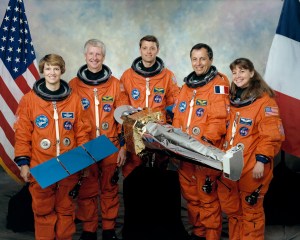On December 4, 1996 a Delta II rocket blasted off from Cape Canaveral, Florida sending the Mars Pathfinder mission, which included the first Mars rover, on its way to deep space.
Pathfinder was NASA’s first return to the Martian surface since the Viking missions in the mid-1970s and a cornerstone of the agency’s new “Faster, Cheaper, Better” philosophy. Lewis Research Center, today NASA Glenn, contributed to both the design and mission phases of Pathfinder.
When the Cold War ended in the early 1990s NASA pivoted from large, expensive exploration missions, such as Viking and Cassini/Huygens, to a series of simpler, more economic endeavors like Deep Space 1 and Mars Pathfinder to demonstrate technologies for future exploration.
The Jet Propulsion Laboratory (JPL) conceived the Pathfinder lander and its Sojourner rover to prove that rover missions to Mars could be accomplished at a reasonable cost and timeframe. Pathfinder was developed in over just three years at the comparatively modest cost of $265 million. It employed a number of unique technologies, including the first use of solar-powered technology on Mars and the first planetary landing to use inflatable airbags to protect the spacecraft.
Early in the process, Lewis engineers applied their years of photovoltaic expertise to design a computer model to predict levels of solar radiation on Mars. Data from the model was used to confirm that Mars possessed sufficient solar energy to power the mission and helped them design solar panels for both Pathfinder and Sojourner.
NASA scientists feared that contamination from the retrorockets like those used on previous missions, might affect soil analysis of the landing site. Instead, they designed a new landing system consisting of a parachute and atmospheric rocket brake to slow the descent, along with a cocoon of airbags to cushion the impact.
Lewis utilized the Space Environments Complex, the largest space simulation chamber in the country, to test the durability of the cloth airbags. Once the pressure inside the chamber was reduced to simulate the Martian environment, a Pathfinder model surrounded by the airbags was dropped from the top of the 122-foot-tall chamber onto an angled board covered with imitation rocks.
The tests proved to be critical since the bags tore open during initial drops. JPL engineers undertook a series of redesigns that resulted in replacing the single thick layer fabric with multiple lightweight layers. Lewis researchers successfully tested the deployment of the new design.
In the early hours of July 4, 1997, Mars Pathfinder began its complex descent to the planet’s surface at 17,000 miles per hour. Minutes later the 24-foot diameter parachute and centrifugal braking system reduced the speed to just 50 miles per hour. Eight seconds before impact, the airbags inflated to form a 19-foot diameter protective bubble around the lander. After bouncing off the ground approximately 15 times Pathfinder came to rest about a half mile from initial impact area, and the groundbreaking Pathfinder mission commenced.
Lewis researchers also contributed experiments to be conducted during the Pathfinder mission, including two sensors to study the suspended dust found near the surface. One was placed beneath a glass window that was retracted briefly each day to compare solar cell performance with and without a layer of dust. Another experimental sensor used crystal frequency to measure the mass of the dust.
Lewis researchers also used Sojourner to study methods for protecting against the buildup of static electricity on the rover wheels. Lewis developed and tested tungsten discharge plates to attract any electrical charges and discharge them into the atmosphere before they overloaded the batteries. In another experiment, Lewis researchers added a metallic coating over one of Sojourner’s wheels to measure the abrasiveness of the Martian surface.
Sojourner operated for 85 days, nearly three times longer than expected. Meanwhile the stationary Pathfinder relayed messages to Earth and photographed the area. The mission produced over 17,000 images, chemical analysis of Martian stones and soil, and 13 technology and science experiments.
From this wealth of information researchers concluded that Mars had previously possessed liquid water and a thicker atmosphere. Pathfinder spurred a series of increasingly larger rover missions to Mars that continues today.
Robert S. Arrighi
NASA’s Glenn Research Center






























